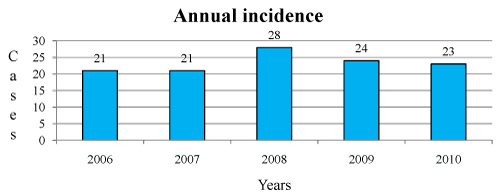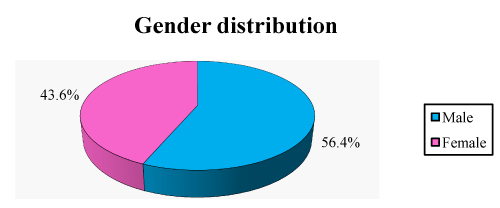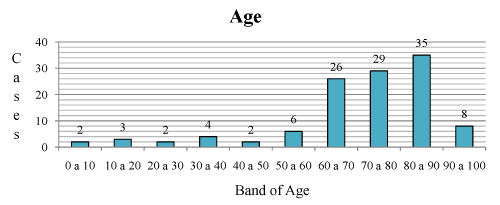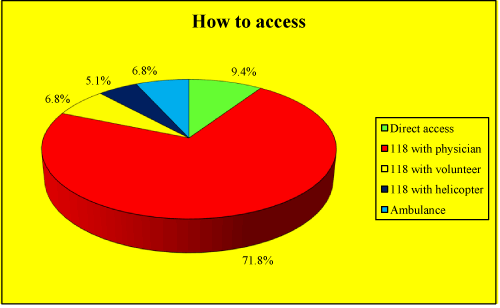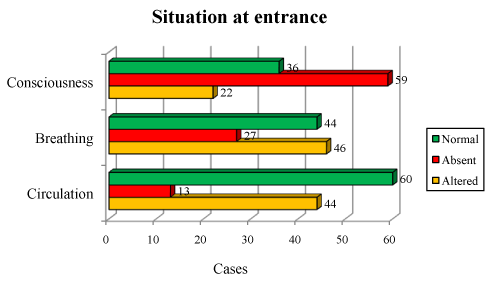| Research Article |
Open Access |
|
| Manassero Daniele |
| New graduate nurse from Villanova Mondovi in the province of Cuneo, Italy |
| *Corresponding authors: |
Manassero Daniele
New graduate nurse from Villanova Mondovi in the province of Cuneo, Italy
Tel: 0174-698034; 339-4844588
E-mail: danielemanassero@hotmail.it |
|
| |
| Received March 24, 2012; Published July 05, 2012 |
| |
| Citation: Daniele M (2012) The Nursing Management of Cardiac Arrest in the Emergency Departments: The Experience of Cuneo. 1: 138. doi:10.4172/scientificreports.138 |
| |
| Copyright: © 2012 Daniele M. This is an open-access article distributed under the terms of the Creative Commons Attribution License, which permits unrestricted use, distribution, and reproduction in any medium, provided the original author and source are credited. |
| |
| Abstract |
| |
| Introduction and objectives of the work: Cardiac Arrest that occurs in Emergency Departments (ED) is a very important but little studied phenomenon. The aim of this paper is to analyze the characteristics of cardiac arrest that occurs in the ED of the Santa Croce and Carle Hospital of Cuneo; observe the nursing management of cardiac arrest in the ED, give a figure of cardiac arrest in Italian’s ED and research in the literature a comparison with the results emerging from the study. |
| |
| Materials and Methods: The study was conducted in the ED of the Hospital of Cuneo. Data were collected retrospectively between January 2006 and December 2010. Furthermore was submitted a questionnaire to all nurses of the ED. |
| |
| Results: A total of 117 cardiac arrests were included in the study. In 42.7% of cases the initial rhythm of cardiac arrest was PEA, in 29.1% Asystole, in 24.8% VF/VT and in 3.4% the rhythm was unknown. Forty-five patients (38.5%) had a Restart of Spontaneous Circulation (69% VF / VT, 20.5% Asystole, 30% PEA). Thirty-six patients (30.8%) were discharged alive from the ED and nineteen (16.3%) survived to hospital discharge. Analysis of questionnaires showed that the nursing staff of the ED is well formed and that the majority of courses were attended for mandatory training. All respondents affirm the usefulness of these courses, 66.6% said that he always felt safe in the management of cardiac arrest and 29.6% consider their pharmacological knowledge not adequate. |
| |
| Discussion: Is confirmed the greater incidence of non-shockable rhythms into the hospital and there is a survival to discharge lowers than in other studies. The nursing management is based on solid theoretical grounds; there are weaknesses pharmacology and briefing/debriefing. |
| |
| Conclusions: Cardiac arrest in the ED is a dramatic phenomenon; adequate nursing management is the key to increase survival. |
| |
| Keywords |
| |
| Cardiac arrest; Nursing Management; Survival; ROSC; Emergency Departments |
| |
| Introduction |
| |
| The Cardio Circulatory Arrest is considered the cardiac emergence for excellence. In fact, it is a dramatic event, unexpected that, if not promptly treated, create irreversible damage. Cardiac arrest is defined as a clinical condition characterized by the simultaneous absence of pulse, breath and consciousness. There are four initial ECG rhythms of cardiac arrest: the Ventricular Fibrillation (VF), pulse less Ventricular Tachycardia (VT), PEA (Pulse less Electrical Activities) and Asystole. The extra-hospital cardiac arrest is often associated with an initial rhythm of VF/VT. In the hospital setting, patients who suffer a cardiac arrest often have significant comorbidities and then present more often rhythms such as PEA and Asystole. In these cases it is important to set strategies to prevent the arrest. The main cause for the arrest is represented by coronary heart disease which is often the result of some chronic diseases such as hypertension, diabetes and hypercholesterolemia. The age at which it occurs more frequently the cardiac arrest is between 45 and 75 years, this in relation to the increased incidence of cardiovascular disease in this period of life. The male sex is most affected. In fact, the World Health Organization (WHO) has estimated an incidence of 1.9 cases per thousand in men and 0.6 cases per thousand in women. Ischemic heart disease is the leading cause of death worldwide and the only cardiac arrest is responsible for about 60% of deaths from ischemic heart disease. It’s an impressive figure especially given that this disease, in addition to high mortality, can lead to a considerable degree of disability. The American Heart Association (AHA) and the European Resuscitation Council (ERC) state that cardiac arrest affects average one person in a thousand every year. The ERC in 2010 estimated that in Europe the cardiac arrest affects 500,000 people each year. According to the same estimates in Italy there are 60,000 new cases each year. The U.S. data is provided by the AHA, in 2010, estimated that each year 785,000 Americans are victims of cardiac arrest. These data confirm the dramatic nature of the phenomenon whose size is progressively increasing. Despite the achievements and advances in medicine that have led to a reduction in mortality from cardiovascular disease, cardiac arrest is still one of the most important health problems worldwide. A very important factor to improve survival is the time. It must take action as early as possible if you want to get an increase in long-term survival and, above all, a satisfactory recovery of neurological function in those afflicted. In fact, for every minute that passes since onset of the arrhythmia to the provision of electric shock, the chances of successful resuscitation decreases by 7-10%. The treatment universally regarded as a «lifesaver» is electrical defibrillation, which is used to interrupt the malignant arrhythmia and restore normal heart rhythm. Defibrillation is effective only on the considered shockable rhythms such as VF and VT. In combination with electrical defibrillation is necessary to begin promptly the Cardio-Pulmonary Resuscitation (CPR). In order to standardize the treatment of cardiac arrest and update knowledge based on the latest scientific discoveries, every 5 years, the ERC shall issue the new guidelines BLSD (Basic Life Support Defibrillation) and ALS (Advanced Life Support). The ERC guidelines were last published in 2010. The main objective of BLSD is the prevention of anoxic brain damage using standardized procedures for Cardio-Pulmonary Resuscitation (CPR) in order to maintain the patency of the airway (Airway), support breathing (Breathing) and circulation (Circulation) whenever the patient suffers a cardiac arrest. The ALS instead uses the most advanced treatments available to resolve the cause of the cardiac arrest and to stabilize the patient. The metaphor of the «Chain of Survival» conceptualizes interventions that contribute to a favorable prognosis after a cardiac arrest. The chain consists of four rings: Early recognition and call for help; Early Cardio-Pulmonary Resuscitation; Early defibrillation treatment and Post-resuscitation care. As one can easily imagine the cardiac arrest is a matter of extreme importance, even from the standpoint of nursing. The nurse plays a key role in the management of cardiac arrest as a witness at the forefront of the patient from the time when the acute event occurs until discharge. In this interval the nurse uses their skills and works with others health professionals in emergency management. The Nurse is an integral part of the resuscitation process, are requested many skills and knowledge that are implemented in a short time with efficiency and timeliness. For example, the Nurse evaluates the ABC, deals with the evaluation of cardiac massage, artificial ventilation and administration of drugs. To better manage the situation, the nurse must necessarily be trained and know how to correctly apply the maneuvers of BLSD and ALS. Therefore, the Nurse is a central figure in the resuscitation process, a figure of vital importance that is bound to have increasing importance in the care of critically ill patients. |
| |
| The aim of this work is: |
| |
| • Analyze the characteristics of cardiac arrest that occurs in the ED of Santa Croce and Carle Hospital of Cuneo. |
| |
| • Observe the nursing management of cardiac arrest in ED. |
| |
| • Give a figure of cardiac arrest in Italian’s Emergency Departments. |
| |
| • Search for a comparison in the literature about the findings from the study. |
| |
| Materials and Methods |
| |
| The Emergency Department (ED) has its headquarters in Santa Croce and Carle Hospital in Cuneo, a city that has about 55,000 inhabitants located in North-West Italy. Cuneo Hospital has 731 beds and is recognized as «Institutions of National Importance and Specialization.» The ED has six examination rooms, two operating theaters, a radiology room and two intensive care units. For each day shift in the structure are present: Two Doctors of Emergency Medicine, an orthopedist, a radiologist, seven nurses and three health care and social assistance operators. The ED has a catchment area, calculated on the province, about 500,000 people. In 2010 in this structure there were 77,698 entrances. If one considers the period between January 2006 and December 2010 there were 376,465 accesses with 185 deaths (0.05%). |
| |
| Data were collected retrospectively in the period between January 1, 2006 and December 31, 2010. To obtain these data we used the Hospital Information System called «Hippocrates». The study included all cardiac arrests that occurred within the Emergency Department who were treated by medical staff of the ED. The criterion for inclusion in the study is based on making the diagnosis of cardio-circulatory arrest in the ED. The diagnosis was made by the medical staff of the ED with reference to the definition of cardiac arrest ERC. Are excluded from the study all cardiac arrests that occurred before arrival at the ED and there are no exclusion criteria for age, sex, race and socioeconomic status. |
| |
| Results |
| |
| In the four years of study, in the ED of Cuneo, there were 376,465 accesses. A total of 117 patients were included in the study (0.03%). Table 1 and Chart 1 represent the yearly distribution of cardiac arrests. |
| |
|
|
Table 1: Annual distribution of cardiac arrests. |
|
| |
|
|
Chart 1: Annual incidence of cardiac arrests. |
|
| |
| Distribution by sex |
| |
| The sample of study consists of 66 patients male (56.4%) and 51 patients female (43.6%) (Chart 2). As noted in numerous studies, the incidence of cardiac arrest is greater in the men. This is mainly due to lower incidence of cardiovascular disease in women. This is determined primarily by protection from atherosclerosis provided by estrogen before menopause. In this regard, the World Health Organization (WHO) states that, in the world, the death for cardiac arrest has an incidence of 1.9 cases per thousand for men and 0.6 cases per thousand women. |
| |
| |
|
|
Chart 2: The gender distribution. |
|
| |
| Stratification by age |
| |
| The sample had a medium age of 69.8 years, a median of 70 years and an age range between 0 and 95 years. In Table 2 and Chart 3 shows the number of arrests by band of age and their percentage. |
| |
|
|
Table 2: Stratification by age. |
|
| |
|
|
Chart 3: Stratification by age. |
|
| |
| The risk of cardiac arrest increases exponentially with age. As one can easily deduce the age group most affected by cardiac arrest is between 60 and 90 years. This finding is consistent with other studies and confirms the close relationship that exists between the occurrence of atherosclerotic disease, which we know occur with age, and the onset of the cardiac arrest. |
| |
| How to access the ED |
| |
| Also interesting is the way in which patients, who then suffered a cardiac arrest, arrived in the ED (Chart 4). Analysis of data shows that: |
| |
|
|
Chart 4: How to access the ED. |
|
| |
| • 11 patients have come to ED with your own vehicle (9.4%). |
| |
| • 84 patients have come to ED with the System 118 with physician (71.8%). |
| |
| • 8 patients have come to ED with the System 118 with a volunteer (6.8%). |
| |
| • 6 patients have come to the ED by helicopter with the System 118 (5.1%). |
| |
| • 8 patients have come to the ED with ambulance (6.8%). |
| |
| Situation at entrance |
| |
| This section describes the clinical situation of the patient when they arrived to the Triage. Are evaluated the three parameters that define the cardiac arrest: consciousness, breathing and circulation. Table 3 and Chart 5 show the results. The data collected by the Triage allow us to observe that a considerable proportion of patients (59) arrived unconscious in the ED, in 22 cases was reported alteration of consciousness while in 36 cases the consciousness was evaluated normal. With regard to the breath in only 27 patients the breath has been assessed as absent. Instead it was found in 46 cases of impaired breathing and in the remaining 44 there were no respiratory alterations. 60 patients arrived without alteration of circulation, in 44 cases the circle was considered abnormal and in only 13 cases the circle was considered absent. |
| |
|
|
Table 3: Situation at entrance. |
|
| |
|
|
Chart 5: Situation at entrance. |
|
| |
| Diagnosis at entrance |
| |
| Still referring to data collected in the Triage, Table 4 shows the input diagnoses, made by the nurses of Triage, of patients who later suffered cardiac arrest. As can be seen the loss of consciousness is the condition that has been found most frequently in the analyzed sample. In fact, 46 diagnoses signaled as the main problem the loss of consciousness. Another common diagnosis is chest pain that, as we know, often indicates the presence of myocardial ischemia. This diagnosis was made in 24 cases while the diagnosis of dyspnea appears 18 times. These groups of three diagnoses, which alone cover more than 75% of the total, clearly indicate the close relationship that exists between cardiovascular problems and cardiac arrest. In only 7 cases of cardiac arrest is traumatic nature. Have also been made the diagnosis of abdominal pain (7 cases), neurological signs (6), gastrointestinal bleeding (2), pulmonary embolism (2), aspiration (2), headache, fever and cardiac tamponade (1). |
| |
|
|
Table 4: Diagnosis at entrance. |
|
| |
| Color code assigned |
| |
| Another data that can be analyzed is the color code that was assigned to patients who suffered a cardiac arrest in the ED (Chart 6). |
| |
|
|
| |
| The Nurse of Triage assigned the Red Code in 94 cases (80.3%), in 21 cases the Yellow Code (18%) and in 2 cases, the Code Green (1.7%). |
| |
| As you can see from the chart the color code most assigned is the red, the code that indicates the most serious situation and requires immediate action to save the life of the patient. In about one cases in five was assigned a yellow code, while in two cases were assigned the green code. Clearly, the Green Code, as it represents urgency deferrable, doesn’t suggest the possibility that a cardiac arrest occurs. So one might suppose an error in the assignment of color code. |
| |
| Initial rhythms |
| |
| The initial rhythms of cardiac arrest are basically four. There are the Ventricular Fibrillation (VF) and pulseless Ventricular Tachycardia (VT) which are shockable rhythm and Asystole and Pulseless Electrical Activities (PEA), which are non-shockable rhythm. In Table 5 and Chart 7 are represented in the initial rhythms found in the sample studied. |
| |
|
|
Table 5: Initial Rhythms of cardiac arrest. |
|
| |
|
|
Chart 7: Initial Rhythms of cardiac arrest. |
|
| |
| In the sample analyzed the initial rhythm that occurred with greater frequency was the PEA (50 cases, 42.7%). In 34 cases (29.1%) the initial rhythm was Asystole, in 29 cases (24.8%) the VF/VT. Then there are 4 cases (3.4%) whose rhythm were not recorded in clinical folders and then remains unknown. |
| |
| It may be noted that, as indeed throughout the hospital setting, non-shockable rhythms (asystole and PEA) are much more frequent than those shockable (VF, VT). This is due to the fact that people, who suffer cardiac arrest in the hospital, usually have a clinical condition worse than in a person who suffers a cardiac arrest outside of it. In hospital we can expect more a rhythm like PEA and Asystolia, while, in a person in apparent state of health, which undergoes a cardiac arrest outside the hospital, we can expect a VF or VT. |
| |
| The initial rhythms data represent one of the most studied fields of cardiac arrest, in fact, in most of the published studies, this data is always displayed. There are numerous studies that have analyzed the initial rhythms, but for a comparison more context we will use the Italian data. Since there are no data on cardiac arrest in Italian Emergency Departments will refer to the intra-hospital data. |
| |
| For example, the project ACRO1 conducted at the Careggi Hospital in Florence investigated 97 cases of ACC occurred in hospital. This study found that the initial rhythm was: |
| |
| • In 56% of the cases Asystole. |
| |
| • In 18% PEA. |
| |
| • In 17% VF / VT. |
| |
| • In 9% Bradycardia. |
| |
| As in the present study, the non-shockable rhythms (PEA, Asystole) have the upper hand over those shockable (83% vs 17% in the project ACRO and 75.2% vs. 24.8% in our study). We may also note that while in Cuneo the most frequent rhythm is the PEA (42.7%) in Florence was the Asystole (56%). Rediscounted values were comparable with regard to the shockable rhythm (17% in Florence and 24.8% in Cuneo). However, both studies confirm that non-shockable rhythms occur more frequently than those shockable. |
| |
| A study2 published in 2004 by Sandroni et al. studied a sample of 114 people that suffered a cardiac arrest in the Gemelli Hospital in Rome. It was observed that the initial rhythm was: |
| |
| • In 46% of the cases Asystole. |
| |
| • In 22% PEA |
| |
| • In 28% FV |
| |
| • In 4% VT |
| |
| Also in this case the rhythm not shockable prevail over the shockable (68% vs 32%), this ratio is very similar to that observed in this study (75.2% vs 24.8%). Asystole is the most common initial rhythm(46% of cases), followed by VF (28%), PEA (22%) and VT (4%). As can be noted, in the study by Sandroni was detected a higher percentage of shockable rhythms (32% vs 17% in Florence, and 24.8% of Cuneo). In addition in Cuneo was found nearly double the percentage of PEA (22% vs 42.7%) compared to the study of Rome. However, the study of Rome and that of Cuneo, for the sample size and for the results seen, have several elements in common. |
| |
| Another research3 with which you can compare the present study was conducted at the San Luigi Gonzaga Hospital in Orbassano between 2004 and 2005. Data were collected from the Medical Emergency Team (MET) and were analyzed 110 cases of cardiac arrest. |
| |
| The initial rhythm detected was: |
| |
| • In 44% of the cases Asystole |
| |
| • In 43% PEA |
| |
| • In 13% VF / VT |
| |
| In this study, there is a predominance of non-shockable rhythm (87% vs 13%). The initial rhythm most frequently found was Asystole (44%). The data concerning the PEA is comparable with the data of our study (43% vs 42.7%) while in Cuneo VF / VT exceeds by about 10 percentage points since Orbassano. |
| |
| The three studies cited as comparisons are different between them but the figure that unites them all is the increased incidence of hospital non-shockable rhythms. In conclusion we can say that the present study is in line with Italian-hospital data. |
| |
| The ROSC |
| |
| Another important fact to analyze the cardiac arrest is the ROSC, English abbreviation which stands for «Restart of Spontaneous Circulation» or the resumption of spontaneous circulation. In Table 6 shows the data collected in the sample studied. |
| |
|
|
| |
| If one considers the entire sample (117 patients) there was a ROSC in 45 cases (38.5%). Then, looking at the rate of ROSC in relation to the initial rhythm can be seen that in the rhythm VF/VT the ROSC rate is 69%, in PEA 30% and in Asystole 20.5%. In 3 cases there was a ROSC but we don’t know the initial rhythm, although we may suppose that they were not shockable rhythms as it were not shocked. To obtain a comparison will use the three studies already cited previously for the analysis of the rhythms of presentation. |
| |
| The Project ACRO did not investigate this aspect while the study of Sandroni noted that there has been ROSC in 96 cases (84%). This finding is discordant with respect to the data of our study because the rate of ROSC is much higher in Rome than in Cuneo (84% vs 38.5%). This difference is only partly explained by the fact that in the study of Gemelli Hospital the percentage of shockable rhythms is greater (32% vs 24.8%). Instead the study conducted at San Luigi Hospital in Orbassano, considering all the rhythms, ROSC occurred in 17% of cases. In comparison with the present study, we see that the rate of ROSC in Orbassano was halved compared to Cuneo (17% vs 38.5%). Furthermore, the research of San Luigi Hospital has estimated that, considering only the shockable rhythms, the percentage increases to 67% ROSC equalizing in fact a similar proportion of Cuneo (69%). |
| |
| Treatment of the cardiac arrest |
| |
| Let us now see what treatment has been undertaken by the medicalnursing team of the ED. Treatment data were systematized into four categories according to the interventions provided. Then there is a fifth category in which was not undertaken resuscitation because the patient was terminal. For convenience has been assigned a number for each type of treatment. Table 7 and Chart 8 summarize the treatments undertaken. |
| |
|
|
Table 7: The treatments undertaken. |
|
| |
|
|
Chart 8: The treatments undertaken. |
|
| |
| Treatment started more frequently (38.5%) is what provides the External Cardiac Massage (ECM) associated with drugs (atropine + adrenaline) and Oro-Tracheal Intubation. The second treatment most used provides drugs associated with ECM (23.9%). In 17.1% of the cases in addition to the MCE and drugs has been used the Oro-Tracheal Intubation and the electrical defibrillation. In 15.4% was applied the same treatment without Intubation. In the remaining 5.1% of cases the treatment was not undertaken because the patient was terminal. |
| |
| As can be seen there is a discrepancy between the number of cases with VF/VT and the number of cases shocked (29 vs 38). One might therefore expect that was shocked cases with non-shockable initial rhythm. We cannot say with certainty, however, the opposite can be assumed that defibrillation is due to the onset of VF / VT at a later time, although the first recorded rhythm was Asystole or PEA. This we cannot know because records in clinical folders there were clear indications but only the summary of the treatments undertaken. |
| |
| Survival from cardiac arrest |
| |
| Other fundamental data to analyze the cardiac arrest is the survival. In Table 8 and Chart 9 shows the survival to discharge from the ED. |
| |
|
|
Table 8: Survival to discharge from the ED. |
|
| |
|
|
Chart 9: Survival to discharge from the ED. |
|
| |
| Looking at the graph we notice that most people (81 cases, 69.2%) who underwent a cardiac arrest in the ED died before discharge from the emergency department. Only 36 patients (30.8%) were discharged alive from the ED and transferred to hospital wards. One can therefore conclude that, even in the short term, the cardiac arrest has a very high mortality as approximately 7 out of 10 die in the emergency department. Table 9 shows the survival to hospital discharge. |
| |
|
|
Table 9: Survival to hospital discharge. |
|
| |
| It may be noted that, of the 36 patients discharged alive from the ED, only 19 were discharged alive from the hospital (16.3%). The remaining 17 cases (14.5%) died within the departments in which they were admitted. |
| |
| In this study, we also investigated the survival correlated with the initial rhythm of the cardiac arrest (Table 10). |
| |
|
|
Table 10: Survival rate related to the initial rhythm. |
|
| |
| Looking at the table we see immediately that the vast majority of people discharged alive from the hospital had a shockable rhythm. This fact confirms the effectiveness of electrical therapy as the only, true «life-saving therapy.» In fact, only 4 people who had a shockable rhythm of presentation don’t have survived to hospital discharge. |
| |
| It can also analyze the survival in relation to the assigned color code. In the sample study it was observed that: |
| |
| • 33 Red Codes were discharged alive from the ED, 17 of these were discharged alive from the hospital |
| |
| • 3 Yellow Codes were discharged alive from the ED, 2 of them were discharged alive from the hospital |
| |
| It follows that: |
| |
| • For the Code Red survival at discharge from the ED is 35.1%, at discharge from the hospital it is 18.1% |
| |
| • For the Code Yellow survival at discharge from the ED is 14.3%, at discharge from the hospital it is 9.5% |
| |
| Although the portion of Codes Yellow is more meager (21 cases against 94) leaps to the eye, a smaller percentage of survival compared to the Codes Red (14.3% vs 35.1% at discharge from the ED and 9.5% vs 18.1% at discharge from the hospital). This finding is surprising and difficult to interpret: paradoxically, in proportion, more patients died with Code Yellow than with Code Red. Some explanations are conceivable: |
| |
| • Surely the number of codes Yellow is not statistically valid |
| |
| • The boundary between the assignment of a Code Yellow and Code Red can be very fine, the evaluation is operator dependent and may elapse different variables |
| |
| • The Code Yellow has waiting times longer than Red and likely will be covered in more delay, thus reducing the chances of survival |
| |
| To obtain a comparison will be used the three studies already mentioned above. |
| |
| In Project ACRO survival rates in VF/VT is estimated at 50%, while the PEA this percentage drops to 12%. In our study the survival rates in VF/VT is slightly lower (41.4%) while for the PEA, the percentage of Florence is twice that of Cuneo (12% vs 6%). |
| |
| In the study conducted at Policlinico Gemelli in Rome there was a survival to hospital discharge of 32%, even here the percentage is twice that of Cuneo (32% vs 16.3%). |
| |
| In the study conducted at the San Luigi Gonzaga Hospital in Orbassano the estimated survival to discharge was similar to that of Rome’s (33% vs 32%). The figure is still much higher than that observed in Cuneo (33% vs 16.3%). |
| |
| Waiting time vs Survival |
| |
| Recognizing the time as one of the key factors to increase the survival cannot be exempt from analyzing the waiting time in relation with the survival. Table 11 shows the data collected. |
| |
|
|
Table 11: Waiting time vs. Survival. |
|
| |
| As already known, before we intervene with treatment, greater are chances that the actions taken are effective. Essentially, the above data confirm this thesis, with the highest percentages of 30-35% that occur before 5 minutes. Do not confuse the survival of 30.7% to more than thirty minutes for the amount of patients who have had access to treatment after that time is scarce. Despite that fact, the trend of survival after 5 minutes, down to reach 0% to 60 minutes. |
| |
| Given that there are times of maximum response to the various color codes is interesting to see if these are met. The maximum response time for Color Code are: |
| |
| Code Red → 0 minutes |
| |
| Code Yellow → 10 minutes |
| |
| Code Green → 60 minutes |
| |
| Code White → 120 minutes |
| |
| Analyzing the clinical folders we can observe that there were delays in 22 Code Red (18.8%) and in 7 Code Yellow (5.9%). In total in 24.7% of cases there was a delay in processing. This figure is not too reliable because not always, when you take charge of a patient, there is immediately on the Computer folder admission of the patient and then the computer might register an hour later than when it is actually spoken. Nevertheless there is 1 case of Code Red and 2 cases of Code Yellow in which action was taken very late. On Code Red first mentioned the delay was 20 minutes while in the two Yellow codes delay was 101 and 201 minutes. The average waiting time in the entire study sample is 8.5 minutes. If you want to investigate the average waiting time for each code is known that the Red is 4 minutes, 8.5 minutes for the Yellow and Green for 5 minutes. The latter value is indicative little as cases of Code Green are only two. |
| |
| Survey on nursing management of cardiac arrest in the Emergency Department of Santa Croce and Carle Hospital of Cuneo |
| |
| The purpose of this study is to discover how it is managed, from the standpoint of nursing, cardiac arrest in the ED of Cuneo. For this research I used a questionnaire. The questionnaire is addressed to all nurses of the ED in Cuneo and consists of 16 multiple choice questions. It focuses mainly on the training of nurses and nursing management of the cardiac arrest. The questionnaires were distributed in January 2011 to all the 50 Nurses of the ED of Cuneo, 26 nurses responded to the questionnaire (52%). Nurses who responded were male in 11 cases (42.3%), females in 15 cases (57.7%). The average age of respondents is 36.4 years and mean time from which work in the ED is 9.3 years. To simplify the understanding of the data collected in the survey question followed by tables, graphs and a brief explanatory comment. |
| |
| 1) Which of these training courses you attended? (Give more options) |
| |
|
COURSE ATTENDED
|
NURSES
|
%
|
|
BLSD (Basic Life Support Defibrillation)
|
26
|
100%
|
|
PBLSD (Pediatric Basic Life Support Defibrillation)
|
23
|
88.4%
|
|
ALS (Advanced Life Support)
|
25
|
96.1%
|
|
TRIAGE
|
26
|
100%
|
|
118
|
17
|
65.4%
|
|
PHTLS (Pre-Hospital Trauma Life Support)
|
18
|
69.2%
|
|
METAL (Medical Emergency Team Alert)
|
7
|
26.9%
|
|
Other
|
MIMMS (Major Incident Medical Management and Support)
|
2
|
7.7%
|
|
ATCN (Advanced Trauma Care for Nurses)
|
1
|
3.8%
|
|
NBCR (Nucleare, Batteriologico, Chimico e Radiologico)
|
2
|
7.7%
|
|
| |
| Analysis of data shows that all the nurses who responded to the questionnaire have attended the course BLSD and TRIAGE (26 nurses, 100%). We can affirm that the basic life support and the ability to evaluate critically ill patients are skills that all respondents possess and that put into practice every time if the need arises. A very high percentage of Nurses (96.1%, 25 of 26) has attended the ALS course and is therefore capable of providing advanced care to the patient. Another significant proportion is that of nurses who attended the PBLSD (88.4%), so most of the staff of the ED is able to support basic life functions even in the child. The analysis also revealed that 69.2% of respondents attended the PHTLS and 65.4% supported the current 118. Other courses attended by nurses are the METAL (26.9%), the MIMMS (7.7%), the NBCR (7.7%) and ATCN (3.8%). One can safely say that the study sample is properly trained, they are positively surprised by the fact that so many future colleagues are so well formed, the rest of the training is a fundamental aspect of our profession. |
| |
| 2) The ALS course, if you attended, dates back to many years ago? |
| |
|
TIME
|
NURSES
|
%
|
|
Less than one year ago
|
6
|
24%
|
|
Between 1 and 2 years ago
|
5
|
20%
|
|
Between2 and 3years ago
|
6
|
24%
|
|
More than3years ago
|
8
|
32%
|
|
| |
 |
| |
| In the second question I investigated how much time has elapsed since attending the ALS course. The questionnaires show that the course ALS was attended. |
| |
| • From 6 Nurses (24%) less than a year ago. |
| |
| • From 5 Nurses (20%) in a period between one and two years ago. |
| |
| • From 6 Nurses (24%) in a period between two and three years ago. |
| |
| • From 8 Nurses (32%) more than three years ago. |
| |
| It may be noted that the training of nurses who responded to the questionnaire is very recent; this finding is supported by the fact that 68% of Nurses have attended the ALS less than three years ago. This is also due to the strategy of hospital organizations that promote retraining programs (every two/three years) to ensure that the skills learned, whether theoretical or practical, are maintained and updated. |
| |
| 3) Which of these courses has attended mandatory training for? (Give more options) |
| |
|
COURSES REQUIRED
|
NURSES
|
%
|
|
BLSD
|
26
|
100%
|
|
PBLS
|
23
|
88.4%
|
|
ALS
|
25
|
96.1%
|
|
TRIAGE
|
25
|
96.1%
|
|
118
|
15
|
57.7%
|
|
Other
|
MIMMS
|
2
|
7.7%
|
|
ATCN
|
1
|
3.8%
|
|
| |
| As one can easily imagine the majority of courses have been dating for mandatory training. The percentages more mandatory are found in the course BLSD (100%), in the course ALS and TRIAGE (96.1%) and in the course PBLS (88.4%). Follow detached the course 118 (57.7%), the MIMMS (7.7%) and ATCN (3.8%). |
| |
| 4) These courses are useful for improving the management and principals of the emergency? |
| |
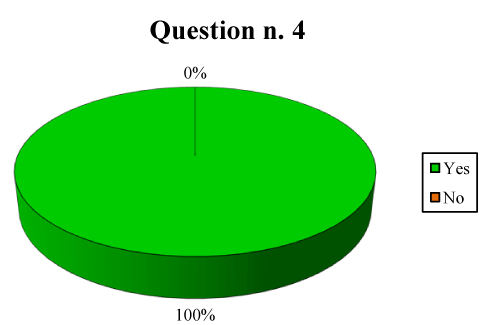 |
| |
| All 26 nurses who responded to the questionnaire stated that the courses attended were useful to improve the management and principals of the emergency. The fact that all respondents have a positive assessment means that these courses are really training and support nurses in their daily work. |
| |
| 5) What have improved these courses? (Give more options) |
| |
|
ANSWERS
|
NURSES
|
%
|
|
Use of medicalequipment
|
20
|
76.9%
|
|
Use of the procedures
|
23
|
88.4%
|
|
Pharmacologicalknowledge
|
20
|
76.9%
|
|
Autonomy on emergency management
|
23
|
88.4%
|
|
| |
| All four items under investigation, obtained a considerable percentage, this means that, in any questioning, the training courses have «left» something. As many as 16 nurses (61.5%) claim that the courses have served to improve all aspects of the four suspects. Nurses have indicated that the use of procedures in emergency management and autonomy (88.4%) are the aspects which are more improved. The other two aspects (use of pharmacological aids and knowledge) were reported less frequently (76.9%) but the rate still remains high. One can safely say that these courses are served at the nursing staff of the ED to improve the major aspects of management of the cardiac arrest. |
| |
| 6) How you consider the training received by these courses? |
| |
|
TRAINING RECEIVED
|
NURSES
|
%
|
|
Excellent
|
12
|
46.2%
|
|
Adequate
|
14
|
53.8%
|
|
Sufficient
|
0
|
0%
|
|
Insufficient
|
0
|
0%
|
|
| |
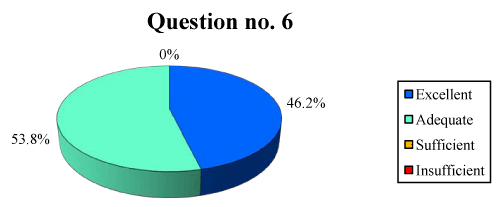 |
| |
| Even in this case, all the nurses gave positive responses; in fact, each of them believes their knowledge appropriate or excellent. The percentage of those who judge their knowledge as excellent was 46.2% and 53.8% considers them appropriate. No one has answered that considered his knowledge sufficient or insufficient. This figure is a very good thing because; as the healthcare provider is aware of its capabilities, the more able to better manage the emergency situation. |
| |
| 7) Have you had the opportunity to experiment in the management of the Cardiac Arrest? |
| |
|
MANAGEMENT OF CA
|
NURSES
|
%
|
|
YES
|
24
|
92.3%
|
|
NO
|
2
|
7.7%
|
|
| |
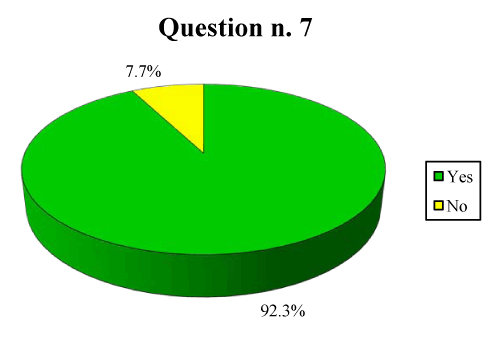 |
| |
| An analysis of the evidence suggests that 92.3% of Nurses have already had occasion to experiment in the management of the cardiac arrest. The high percentage means that it is not uncommon for a nurse who works in the ED, find themselves managing a cardiac arrest. In fact, only two of the 26 nurses interviewed (7.7%) have never had the opportunity to manage a cardiac arrest. It ‘so good that every nurse who works in the ED is adequately trained and that even with the help of more experienced colleagues, learns to properly handle this type of emergency. |
| |
| 8) If yes, with regard to your skills, you always felt safe in the management of the cardiac arrest? |
| |
|
SAFETY
|
NURSES
|
%
|
|
YES
|
16
|
66.6%
|
|
NO
|
8
|
33.3%
|
|
| |
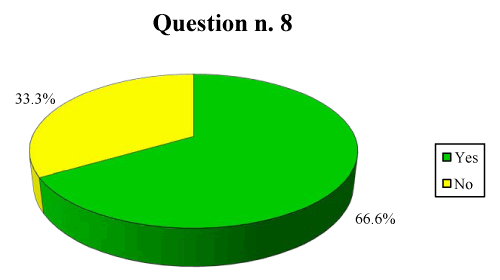 |
| |
| Of the 24 nurses who have already managed a cardiac arrest, 16 felt confident in their actions while the remaining 8 did not feel safe. This stems from the fact that in the management of cardiac arrest can intervene many variables which often complicate the process of resuscitation. Not by chance to help nurses and other professionals in managing this type of emergency, there are organizational procedures that assign each user a specific task to be performed in a defined time. Nevertheless it remains difficult, even from the emotional point of view; handle this event without any problems. Certainly the experience and training can help the operator to act with confidence, to ensure appropriate care to the patient. |
| |
| 9) Have you ever run a cardiac arrest by Team Leader? |
| |
|
TEAM LEADER
|
NURSES
|
%
|
|
YES
|
10
|
38.4%
|
|
NO
|
16
|
61.6%
|
|
| |
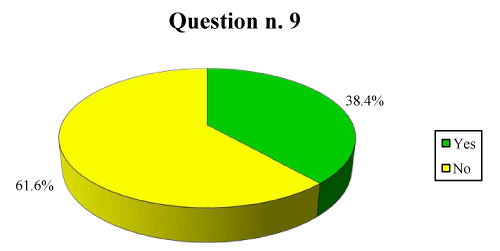 |
| |
| In the ninth question I want to investigate how many nurses have already managed a cardiac arrest by Team Leader, or by the team coordinators in the resuscitation process. It turns out that only 10 nurses (38.4%) have served as Team Leader while 16 (61.6%) have never played. The Team Leader must have a range of skills and organizational skills to coordinate the other operators. It is not easy to play a role, because much depends on the personality of each operator. |
| |
| 10) Have you felt safe when the cardiac arrest was managed by another Team Leader? |
| |
|
SAFETY
|
NURSES
|
%
|
|
YES
|
18
|
75%
|
|
NO
|
6
|
25%
|
|
| |
 |
| |
| Nurses have responded in 18 cases yes (75%) and in 6 cases no (25%). Too many variables involved in this aspect, often emotional, but you can still say that 3 out of 4 nurses feel safe when the cardiac arrest is managed by another Team Leader. |
| |
| 11) You can prepare and use, in collaboration with the physician, the defibrillator? |
| |
|
DEFIBRILLATION
|
NURSES
|
%
|
|
YES
|
26
|
100%
|
|
NO
|
0
|
0%
|
|
| |
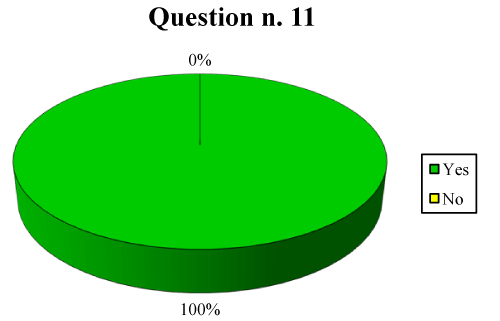 |
| |
| All nurses who responded to the questionnaire said they can prepare and use the defibrillator in collaboration of Doctor. We can therefore say that the ability to defibrillate is guaranteed by all the nurses of the ED. |
| |
| 12) You were trained to use the manual defibrillator? |
| |
|
TRAINING
|
NURSES
|
%
|
|
YES
|
25
|
96.1%
|
|
NO
|
1
|
3.9%
|
|
| |
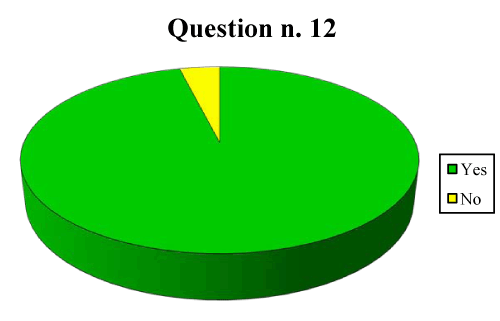 |
| |
| As many as 25 nurses (96.1%) say they are trained to use the manual defibrillator, only one, however, has not been trained. The percentage is obviously very high as the nurses working in Emergency Departments will face more frequent cardiac arrests requiring electrical defibrillation and thus need more training than nurses working in wards. |
| |
| 13) How you consider your pharmacological knowledge regarding the cardiac arrest? |
| |
|
PHARMACOLOGICAL KNOWLEDGE
|
NURSES
|
%
|
|
Excellent
|
1
|
3.8%
|
|
Adequate
|
18
|
69.3%
|
|
Sufficient
|
6
|
23.1%
|
|
Insufficient
|
1
|
3.8%
|
|
| |
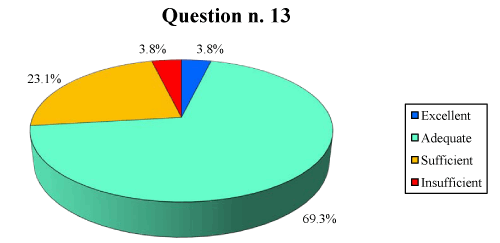 |
| |
| A very important aspect in the management of cardiac arrest is the drug treatment. At this point I asked the nurses how to assess their pharmacological knowledge. It results that the majority, 18 nurses (69.3%), consider their knowledge adequate. Other 6 Nurses (23.1%) claim to have sufficient knowledge, while one nurse considers their knowledge as excellent and another not sufficient (3.8%). Perhaps the pharmacology is the first aspect in which shows some of the weaknesses into the ED personnel, in fact, more than one in four nurses (26.9%) did not consider their pharmacological knowledge adequate but sufficient or even not sufficient. To improve this you could suggest, on the one hand to those who organize training courses to put more weight on the pharmacological management of arrest and other advice to nurses to fill this gap, for example, comparing with more experienced colleagues. |
| |
| 14) In the situation where come notified of the arrival of a cardiac arrest, there is provided a moment of Briefing to plan the management of the emergency? |
| |
|
BRIEFING
|
NURSES
|
%
|
|
YES
|
8
|
30.8%
|
|
NO
|
18
|
69.2%
|
|
| |
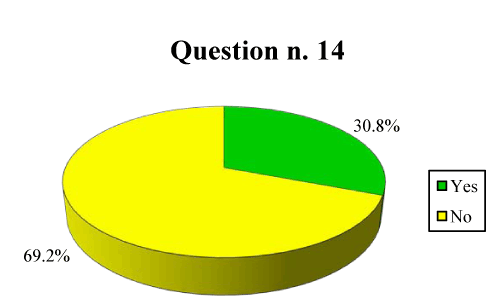 |
| |
| This question 8 Nurses (30.8%) said they have provided moments of briefing while the remaining 18 (69.2%) responded that they are not provided. Since the nurses who work in the same building seems strange that there are so discordant results. However, as also stated in the Manual ALS in 2010, is recommended to determine a time of briefing to better organize the management of cardiac arrest and preestablish the duties of each operator. |
| |
| 15) When the management of this emergency there is a time for debriefing and to analyze the critical strengths of your intervention? |
| |
|
DEBRIEFING
|
NURSES
|
%
|
|
YES
|
12
|
46.2%
|
|
NO
|
14
|
53.8%
|
|
| |
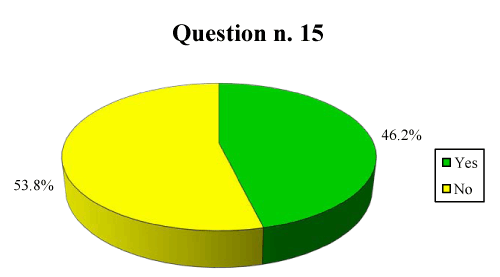 |
| |
| This question Nurses have responded in 12 cases (46.2%) that there is a time of debriefing and in the remaining 14 cases (53.8%) was not expected. That’s the same argument made above, in the same building there are conflicting data. It can be assumed that, depending of health care workers involved is whether or not these moments of comparison. This is definitely one aspect on which the ED Cuneo can work and improve. |
| |
| 16) If yes, who participates in these moments of confrontation? |
| |
|
PROFESSIONAL FIGURES
|
NUMBER
|
%
|
|
Nurses
|
0
|
0%
|
|
Physicians
|
0
|
0%
|
|
Nurses andPhysicians
|
12
|
100%
|
|
Other
|
0
|
0%
|
|
| |
| The 12 nurses who responded that they are provided moments of debriefing have also indicated that these comparisons involved together with Doctors and Nurses. This finding is comforting because it is good that all those involved in the resuscitation process have the opportunity to express their difficulties, to rework the experience and engage with other health professionals on how best to manage cardiac arrest. |
| |
| Conclusions |
| |
| Cardiac arrest in the Emergency Departments remains an understudied phenomenon although it takes a considerable size and as a case study is as mortality. The targets were placed at the beginning of the study are four, below will be analyzed and commented. |
| |
| The first objective is to analyze the characteristics of the arrest that occurs in the ED of Santa Croce and Carle Hospital in Cuneo. For this reason a survey was conducted on a statistical sample of 117 cardiac arrests that occurred in the ED over four years (2006-2010). Data were collected retrospectively using the Informatics System «Hippocrates». Many interesting facts have emerged from the analysis, in particular it was found that in 42.7% of cases the initial rhythm of cardiac arrest was PEA, in 29.1% Asystole, in 24.8% VF/VT and the remaining 3.4% the rhythm is unknown. As noted in numerous studies, the initial rhythm of cardiac arrest in the hospital setting is most frequently non-shockable. In addition it was observed that the ROSC occurs on average in 38.5% of patient’s victim of cardiac arrest. If we consider only the VF/VT the ROSC rate is 69%, while for Asystole is 20.5% and 30% for the PEA. In the literature there are several studies that have investigated this aspect, there is a great variability of data, often discordant with this study. For example, a study published by Sandroni found a ROSC in 84% of cases while the study conducted at the San Luigi Hospital of Orbassano on a similar proportion is 17%. Part of the research was conducted on treatments that the team undertakes in the case of cardiac arrest. Treatment started more frequently (38.5%) is what provides the External Cardiac Massage (ECM) associated with drugs (atropine + adrenaline) and Oro-Tracheal Intubation. The second treatment most used provides drugs associated with ECM (23.9%). In 17.1% of the cases in addition to the MCE and drugs has been used the Oro-Tracheal Intubation and the electrical defibrillation. In 15.4% was applied the same treatment without Intubation. In the remaining 5.1% of cases the treatment was not undertaken because the patient was terminal. Another key issue is the survival from cardiac arrest, in this study it was observed that 69.2% of people who have suffered a cardiac arrest in the ED died before discharge from the emergency department and only the remaining 30.8% was discharged alive from the ED. Of these patients, only 16.3% were discharged alive from the hospital while the remaining 14.5% died in hospital. As well as for ROSC there is a great variability of the results in the literature. For example in the study by Sandroni and that of San Luigi Hospital of Orbassano percentages were found survival to discharge by 33% and 32%, almost double the data compared to 16.3% found in Cuneo. Overall we can say that the processing of data collected in Cuneo has produced a good result because most of the characteristics of cardiac arrest were analyzed. |
| |
| The second objective is to observe the nursing management of the cardiac arrest in the ED. To achieve this objective, a questionnaire was administered to all 50 nurses of the ED, 26 of them responded (52%). The questionnaire consists of 16 multiple choice questions and concerns primarily the training of nurses and nursing management of the cardiac arrest. It was noted that the study sample is very wellformed. In fact, there are high rates of participation in training (100% to BLSD and TRIAGE, 96.1% to ALS and 88.4% at PBLSD). In addition all nurses who have attended these courses have stated that they were useful to improve emergency management and health facilities. The vast majority of these courses have been dating for mandatory training. It is observed that the highest percentages are found in the course BLSD (100%), in ALS and TRIAGE (96.1%) and in PBLS (88.4%). It was also asked the nurses if you have always felt safe in the management of the cardiac arrest, and found that 66.6% of them have always felt safe while the remaining 33.3% do not. Mild weakness was found in the pharmacological management of the cardiac arrest, in fact, more than one in four nurses (26.9%), does not consider their pharmacological knowledge adequate. It ‘also revealed some divergence of responses on the moments of briefing/debriefing. In fact, 8 nurses (30.8%) said they have provided moments of briefing while the remaining 18 (69.2%) responded that they are not provided. In addition, 12 nurses (46.2%) responded that there is a time of debriefing and the remaining 14 (53.8%) was not expected. The goal that was set being reached as the result was a general framework on the Nursing management of the cardiac arrest in the ED of Cuneo. |
| |
| The third objective is to deliver a figure of cardiac arrest in Italian’s Emergency Departments. The target can be said for now reached, although it is not possible to make a comparison because there are no Italian data of cardiac arrest in ED. Since the topic is very interesting but little studied, one might suggest continuing the study of Cuneo in the ED, or embarking on a new one in other Emergency Departments. |
| |
| The ultimate goal is to seek in literature a comparison of the results emerging from the study. As mentioned earlier, there are no Italian data have investigated the cardiac arrest that occurs in the Departments of Emergency, for this reason it was not possible to make a comparison in context. Therefore, to obtain a comparison-hospital statistics were used. |
| |
| The idea of conduct research in the ED of Cuneo was born from a beautiful experience of Clinical Training that I was lucky to attend at the third year of University. I particularly remember a day when there was a cardiac arrest and was amazed and fascinated by the organization that the team had to manage this emergency. From that moment he was born my desire to know more, I studied and I finally decided to make the topic of my thesis. In a first phase was followed by the general documentation of research data on cardiac arrests that occurred in ED over four years. Here I encountered the first difficulties in that, today, the ED is not used in the «Utstein Style», so I had to go back to the data using the Information System «Hippocrates». Despite this difficulty, my work has gone on and I prepared and administered the questionnaires to nurses working in ED. Responded to the questionnaire were only 26 nurses, this is a little edge because the results that have emerged, based on responses from just over half of the nursing staff. At the research was complemented by a theoretical part where I highlighted what the cardiac arrest, as often occurs, as is discussed and issues in nursing management. Finally we tried to compare the results with the theoretical assumptions previously set. As regards the management of the cardiac arrest there were no problems in that the team that manages the cardiac arrest follows the lines ERC issued in 2010. Instead, as stated previously, the results of the statistical study were compared with inhospital data , this is a limitation of this work. Overall I am very pleased with the work I did, my desire to pursue this issue has been satisfied and I feel enriched by this experience of research. The nurse has an important role in the management of cardiac arrest, in fact, is a central figure in the resuscitation process, a figure of vital importance that is likely to have increasingly significant role in patient care in cardiac arrest. |
| |
| 1Vergassola R et al. Progetto ACRO, Prevenzione dellâÃâ¬Ãâ¢arresto cardiaco intraospedaliero: uno score per la valutazione del livello di gravità in pazienti ricoverati in degenza ordinaria, Firenze, 2001. |
| |
| 2Sandroni C, Ferro G, Santangelo S, Tortora F, Mistura L, Cavallaro F, Caricato A, Antonelli M. In-hospital cardiac arrest: survival depends mainly on the effectiveness of the emergency response, 2004. |
| |
| 3Maniero M, Penso R, Vacchelli R. L’emergenza intraospedaliera: il medicalemergency team a un anno dalla sua istituzione”, da Infermiere Informazione n. 5-6 Settembre-Dicembre, 2005. |













